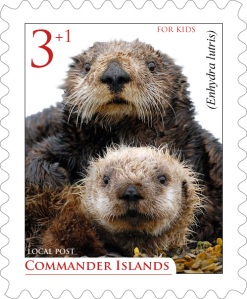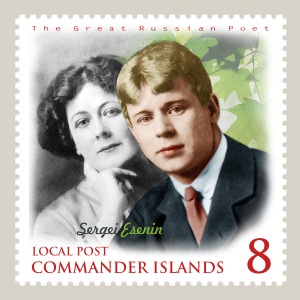North Pacific International Waters
Cinderella stamps
Opening of the Commander Islands Vitus Bering.
 Opening of the Commander Islands Vitus Bering 1741 stamp
Opening of the Commander Islands Vitus Bering 1741 stamp
The first branch of the expedition departed from St. Petersburg in February 1733. Crossing Siberia, the jealous crowd of officials, workers stubborn and rebellious scientists, began a three-year nightmare for the Bering. By 1740 preparations were completed in Okhotsk, and the expedition sailed to Kamchatka, where he spent the winter. Behring moved in June 1741 with two ships, but was soon accompanying ships were separated, and the Bering went on his way only to his vessel, St. Peter. He changed his course towards the northern lands July 16. A few days later he landed at what is now Kayak Island, but physically and emotionally exhausted, and afraid to get into the trap of “opposing winds, Bering returned to Kamchatka. The team sailed in a southwesterly direction, charting approaches to the coast on its way. By the end of August Bering became too ill, and he could not even go out of his cabin. November 4th coast of one of the islands, which are now known as the Commander Islands, was seen. On the wrecked vessel and to numerous patients, Behring decided to spend the winter on the island. Although he grew weaker day by day, he continued to direct his men until his death on Dec. 8, 1741. He was buried on the island, which is now named for him. In 1742, the Forty-five of the 77 officers and sailors of St. Peter, eventually reached a safe place.
Most Northern Expedition and geographically, and from a scientific point of view has led to numerous discoveries: in particular, it is worth noting that during this expedition was open strait, now named part of the Bering, which divides Asia and America, the Siberian coast from the White Sea to Kolyma River was mapped in detail, and the American coast of the island of Prince of Wales to the Commander Islands were also inflicted on the world map.
The Tufted Puffin (Fratercula cirrhata).
The Tufted Puffin (Fratercula cirrhata) is a relatively abundant medium-sized pelagic seabird in the auk (Alcidae) family found throughout the North Pacific Ocean. It is one of three species of puffin that make up the Fratercula genus and is easily recognizable by its thick red bill and yellow tufts.
The Tufted Puffin was first described in 1769 by German zoologist Peter Simon Pallas. Its generic name is derived from the Latin Fratercula ‘little brother’ and the specific epithet, cirrhata ‘tufted’. Since it may be more closely related to the Rhinoceros Auklet than the other puffins it is sometimes placed in the genus Lunda.
Tufted Puffins form dense breeding colonies during the summer reproductive season from British Columbia, throughout southeastern Alaska and the Aleutian Islands, Kamchatka, the Kuril Islands and throughout the Sea of Okhotsk. While they share some habitat with Horned Puffins (F. corniculata), the range of the Tufted Puffin is generally more southern. They have been known to nest in small numbers as far south as the northern Channel Islands, off southern California. However, the last confirmed sighting at the Channel Islands occurred in 1997.
Tufted Puffins typically select islands or cliffs that are relatively inaccessible to predators, close to productive waters, and high enough that they can take to the air successfully. Ideal habitat is steep but with a relatively soft soil substrate and grass for the creation of burrows.
During the winter feeding season, they spend their time almost exclusively at sea, extending their range throughout the North Pacific and south to Japan and California.
Tufted Puffins feed almost exclusively on fish, which they catch by diving from the surface. Adults may also feed on squid or other invertebrates. Feeding areas can be located far offshore from the nesting areas. Puffins can store large quantities of small fish in their bills and carry them to their chicks.
Tufted Puffins are preyed upon by various avian raptors such as Snowy Owls, Bald Eagles and Peregrine Falcons, and mammals like the Arctic Foxes. Foxes seem to prefer the puffin over other birds, making the bird a main target. Choosing inaccessible cliffs and entirely mammal-free islands protects them from terrestrial predators while laying eggs in burrows is effective in protecting them from egg-scavengers like gulls and ravens.
Collectors Notes:
Date of issue: October, 16, 2010
Designer: Vladimir Marmiloff
Catalog number: 2 (28)
Baird’s Beaked Whale./Плавун Северный.
Overprinted on the stamp Commander Islands.
Baird’s Beaked Whale./Плавун Северный.
Baird’s beaked whale, (Berardius bairdii (Stejneger, 1883), aka north Pacific bottle-nosed whale, is the largest of all the beaked whales reaching up to 12.8 m in length. The species was named for Spencer F. Baird of the Smithsonian Institution, a well-known naturalist in the late 1800s.
This is the largest member of the whale family, longer than a bus and twice the weight of an elephant. Studies of hunted animals hint that these whales may have a complex social structure where male animals play an important role in looking after and nurturing the young.
This whale species has a small head, which equals about 1/8 of the total body length. The Baird’s beaked whale has a distinctive bulbous forehead that slopes steeply to a long, thin beak similar to a dolphin’s beak. When it surfaces to breathe, its head exits the water at a steep angle allowing the bulging forehead, beak, and teeth to be seen clearly. The lower jaw extends 10 cm beyond the upper jaw exposing two sets of teeth near the tip of the snout. Like many other whales, there are no teeth in the upper jaw, and like many beaked whales there are 2 v-shaped throat grooves. The front pair of teeth in the lower jaw is about 9 cm long. A second pair of teeth is found 20 cm behind the front set which is about 5 cm.
The large, round body of Baird’s beaked whale tapers toward both the head and tail. They are blue-gray to brown to black in color on the dorsal side and light gray on the ventral side. A small, triangular fin is located toward the posterior end of the body. The flukes equal about 1/4 the body length and are slightly rounded at the tips with no notch in the center. The small flippers on the anterior end of the body are rounded at the tips.
The blow of the Baird’s beaked whale is low and indistinct making them difficult to detect at sea.
——————————————————————————————————————————–
Северный плавун (Berardius bairdi)
Внешний вид. Длина тела до 15 м, масса 11–15 тонн. Самки больше самцов. Тело длинное, веретеновидное. Голова небольшая, округлая, с выпуклым шаровидным лбом и длинным уплощенным клювом. На нижней челюсти спереди 1–2 пары уплощенных зубов. Массивные зубы первой пары шириной до 85 мм так сдвинуты вперед, что при закрытой пасти торчат снаружи. Зубы второй пары, шириной вдвое меньше, прорезываются редко. Полулунное дыхательное отверстие обращено выпуклой стороной вперед. Расположенный па границе задней трети тела спинной плавник невысокий, притуплённый, с прямым или слегка вогнутым задним краем. Грудные плавники короткие, слегка округлые. Выемка между хвостовыми лопастями не выражена.
Окраска тела однотонно темно-бурая, на боках и брюхе иногда более светлая; на брюшной стороне мелкие белые пятна. Кожа покрыта множеством светлых шрамов и царапин.
Статус. Малочисленный вид.
Местообитания и поведение. Живут северные плавуны в северной части Тихого океана. В наших водах чаще встречаются в Охотском море и у Курильских островов, реже — в Японском и Беринговом морях.
Обитает северный плавун преимущественно в открытых глубоких водах. Встречается обычно группами из 5–20 особей, которые держатся близко друг к другу и совершают погружения синхронно. Под водой находится до 20 минут, после чего задерживается на поверхности на 3–4 минуты, выпуская серию низких широких фонтанов высотой до 1,5 м. При глубоком погружении круто изгибает тело, высоко выставляя спинной плавник и хвостовой стебель, но лопасти хвоста обнажает редко. При выныривании показывает клюв и лоб.
Питание. Главная пища плавунов — головоногие моллюски, а также придонная рыба (скаты и их яйца, морские ерши, тресковые), крабы и крупные раки.
Размножение. Большинство северных плавунов спаривается в феврале, а детеныши рождаются в декабре. Длина новорожденных 4,5- 4,8 м.
Collectors Notes:
Date of issue: October, 8, 2010
Designer: Vladimir Marmiloff
Catalog number: 25
The largest on the purchasing capacity a banknote in the history of paper money.
On stamps fragments Russian Tsar 500 rouble banknotes of 1912 are represented.
To the beginning of the XX-th century the technology of printing of money endured blossoming. At this particular time Expedition of Preparation of the State Papers (nowadays factory Goznak) has involved in cooperation of the well-known painters and engravers – J.Rejhel, A.Zauervejd, F.Lundin, P.Ksidias. As a result of long-term creative searches the image of “Russian currency” has been found. “The Nikolaev” rouble differed masterly complexity of execution, images on it quite often surpassed in complexity and refinement drawings and engravings of the best artists. Advantage in 500 roubles, it is certainly possible to carry last denomination of 1912 to the best samples of world currencies. Besides, the given denomination on purchasing capacity was the largest in the history of paper money.
Collectors Notes:
Date of issue: October, 4, 2010
Designer: Vladimir Marmiloff
Catalog number: 23-24
The Sea Otter.
The Sea Otter (Enhydra lutris)
The sea otter (Enhydra lutris) is a marine mammal native to the coasts of the northern and eastern North Pacific Ocean. Adult sea otters typically weigh between 14 and 45 kg (30 to 100 lb), making them the heaviest members of the weasel family, but among the smallest marine mammals. Unlike most marine mammals, the sea otter’s primary form of insulation is an exceptionally thick coat of fur, the densest in the animal kingdom. Although it can walk on land, the sea otter lives mostly in the ocean.
The sea otter inhabits nearshore environments where it dives to the sea floor to forage. It preys mostly upon marine invertebrates such assea urchins, various molluscs and crustaceans, and some species of fish. Its foraging and eating habits are noteworthy in several respects. First, its use of rocks to dislodge prey and to open shells makes it one of the few mammal species to use tools. In most of its range, it is a keystone species, controlling sea urchin populations which would otherwise inflict extensive damage to kelp forestecosystems. Its diet includes prey species that are also valued by humans as food, leading to conflicts between sea otters and fisheries.
Collectors Notes:
Date of issue: October, 2nd, 2010
Designer: Vladimir Marmiloff
Catalog number: 22
115 years since the birth of Sergei Esenin.
Sergei Alexandrovich Esenin ( October 3 [O.S. September 21] 1895 – December 27, 1925) was a Russian lyrical poet. He was one of the most popular and well-known Russian poets of the 20th century.
http://en.wikipedia.org/wiki/Sergei_Yesenin
Collectors Notes:
Date of issue: October, 3th, 2010
Designer: Vladimir Marmiloff
Catalog number: 21
2010 International Year of Biodiversity.
The Secretariat of the Convention on Biological Diversity has developed a logo for the International Year of Biodiversity. All the organizations and institutions involved in the celebrations for the International Year are invited to use the logo in all their publications and communications.
The logo is available for you to use under certain conditions explained in the Communications Guidelines for the International Year of Biodiversity. Usage of the logo requires completion of the waiver form. All requests concerning the usage of this logo should be addressed to IYB2010@cbd.int.
We encourage you to always include also the Countdown 2010 Logo to promote biodiversity conservation in your area. Please follow the guidelines you can find here. Inform us when you use the Countdown 2010 logo and send a copy of your publication!
Collectors Notes:
Date of issue: Semptember, 26th, 2010
Designer: Vladimir Marmiloff
Catalog number: 17 – 20, Sheet 2









